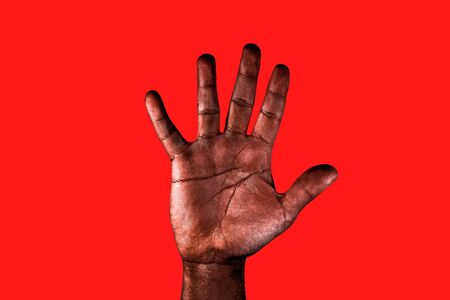Introduction to Palmistry in British Tradition
Palmistry, often known as chiromancy, is a practice that has intrigued generations across the United Kingdom. Rooted in ancient traditions, palmistry involves the careful study of the hands—particularly the shapes, lines, and mounts—to reveal unique insights about personality and destiny. In Britain, palmistry gained prominence during the Victorian era, when curiosity about the mystical arts flourished among all social classes. Esteemed parlours and travelling fairs became hubs for palm readers to share their craft, weaving it into the very fabric of British popular culture. Over time, palmistry established itself not only as a tool for fortune-telling but also as a means of self-reflection and personal growth. Today, it is appreciated both as an entertaining pursuit and a respected aspect of holistic well-being. By examining hand shapes and their associated meanings, individuals in the UK continue to explore what their palms may reveal about their character and life’s potential paths—a tradition that endures with warmth and depth in British society.
2. The Four Classical Hand Shapes in Palm Reading
Within the time-honoured tradition of palmistry, hands are typically categorised into four classical shapes: Earth, Air, Fire, and Water. Each hand type is associated with distinct personality traits and reflects ancient wisdom interwoven with modern understanding. Let us embark on a detailed exploration of these types, weaving in British references and typical attributes seen in individuals from all walks of life across the United Kingdom.
Earth Hands
Earth hands are characterised by their square palms and short fingers, often sturdy and solid to the touch. Much like the steadfast countryside of Yorkshire or the enduring stone walls of rural England, those with earth hands are practical, grounded, and reliable. They value tradition and are known for their hard work and sense of duty—qualities reminiscent of the quintessential British resolve.
Air Hands
Air hands feature square or rectangular palms with long fingers and often pronounced knuckles. Think of the sharp intellects fostered within Oxford or Cambridge; air-handed individuals are analytical, curious, and eloquent. They thrive on communication and rational thought, making them well suited to debate societies or literary circles so beloved in British culture.
Fire Hands
With fire hands, one finds a long palm matched with short fingers. These hands exude energy and confidence, much like the bustling streets of London or the vibrant creativity found at Edinburgh Festival Fringe. People with fire hands are passionate, dynamic, and sometimes impulsive—natural leaders who embrace new challenges with enthusiasm.
Water Hands
Water hands are distinguished by long palms and long fingers, often soft to the touch. Evocative of the tranquil lakes of Cumbria or the poetic mists over Scottish lochs, water-handed individuals possess deep sensitivity, intuition, and empathy. They are artistic souls who appreciate beauty in all its forms—a trait reflected in Britain’s rich heritage of art, music, and literature.
Comparison Table: Classical Hand Shapes & Traits
| Hand Shape | Main Characteristics | Common British Reference | Associated Traits |
|---|---|---|---|
| Earth | Square palm, short fingers | Yorkshire countryside | Practicality, reliability |
| Air | Square/rectangular palm, long fingers | Oxford academia | Analytical mind, communication skills |
| Fire | Long palm, short fingers | London vibrancy | Passionate leadership, dynamism |
| Water | Long palm, long fingers | Cumbrian lakes | Sensitivity, intuition |
The Significance of Hand Shapes in Daily Life
A keen observation of hand shape not only reveals one’s innate tendencies but also provides insight into how a person might respond to life’s myriad situations—be it navigating a rainy British afternoon or engaging in witty banter at a local pub. Through understanding these classical hand types, we gain an appreciation for both individual uniqueness and the subtle threads that bind us together within British society.
![]()
3. Hand Shape Indicators: Fingers, Palms, and Texture
In palmistry, the nuances of hand shape go far beyond the basic categories, delving into finer details such as finger length, flexibility, and the texture of both palms and fingers. These features are thought to reveal subtle aspects of one’s character, temperament, and social inclinations—insights that can be especially intriguing when considered within the context of British daily life.
Finger Length and Proportion
The length of ones fingers relative to the palm is a key marker in hand analysis. Long fingers typically indicate an analytical mind and a penchant for detail. Such individuals may thrive in classic British pursuits like crossword puzzles over a cup of tea or enjoy traditional crafts such as needlework or gardening. In contrast, those with shorter fingers are often seen as pragmatic and action-oriented—traits well-suited to the hustle and bustle of city life in places like London or Manchester.
Flexibility: Stiffness versus Suppleness
The flexibility of the hand and fingers further refines this interpretation. Supple hands suggest adaptability and sociability; people with flexible hands are often at ease mingling at a local pub or adapting to the ever-changing British weather with good humour. Conversely, stiffer hands may denote strong principles and determination—characteristics admired in those who uphold time-honoured traditions or champion causes close to their community’s heart.
Texture: Smoothness and Coarseness
The texture of the skin, whether fine and soft or coarse and rugged, offers yet another layer of meaning. A smooth hand may belong to someone sensitive, refined, and attuned to aesthetics—a lover of classic literature or fine art galleries. Meanwhile, a rougher texture points towards a practical nature, perhaps echoing the hardworking ethos found in British countryside communities or among those who relish DIY projects around their homes.
Social Tendencies Reflected in Hand Features
Taken together, these indicators can reveal much about social preferences: those with supple, smooth hands might gravitate toward cultural events in cities like Edinburgh or Oxford, while individuals with firmer, more textured hands could favour outdoor activities such as rambling through the Lake District or participating in local village fêtes. Thus, by observing these subtle traits, one can gain insights not only into personal tendencies but also how these characteristics harmonise with cherished aspects of British lifestyle.
4. Personality Insights: What Your Hand Shape Says About You
In the realm of palmistry, each hand shape is believed to reveal profound insights into an individual’s character, strengths, and inclinations. By understanding these nuances, one may gain a better appreciation of themselves and those around them. Let us explore how the main hand shapes manifest in personality traits and daily British life.
Overview of Hand Shapes and Personality Traits
| Hand Shape | Personality Traits | British Scenario Example |
|---|---|---|
| Earth (Square Palm, Short Fingers) | Practical, reliable, down-to-earth, steady | Prefers a well-brewed cup of tea at home over an extravagant night out; often dependable in community volunteering such as local charity shops |
| Air (Square Palm, Long Fingers) | Analytical, communicative, curious, witty | Lively participant in a pub quiz night, known for clever banter and quick thinking in group discussions at work or during family gatherings |
| Water (Long Palm, Long Fingers) | Sensitive, creative, intuitive, empathetic | Enjoys long walks along the Cornish coast for inspiration; likely to write poetry or keep detailed journals reflecting on daily life |
| Fire (Long Palm, Short Fingers) | Energetic, passionate, adventurous, spontaneous | The first to suggest a weekend hike in the Lake District or organise a last-minute barbecue despite the unpredictable British weather |
Deeper Interpretations Through Everyday British Lenses
Earth Hands: Those with earth hands are often valued as stalwarts within their circles—much like the neighbour who always lends a hand during village fêtes or helps salt icy pavements in winter. Their practical outlook ensures stability amidst life’s uncertainties.
Air Hands: The air-handed individual brings lightness and intellectual energy wherever they go. Imagine someone who thrives during debates about football results in the local pub or who enjoys crossword puzzles on the train commute—these are your quintessential thinkers and talkers.
Water Hands: With heightened sensitivity and imagination, water hands are well-suited to Britain’s rich artistic traditions. Whether participating in community theatre or appreciating the subtle melancholy of a rainy afternoon spent reading Brontë novels, these souls find beauty in emotion.
Fire Hands: Fire-handed personalities infuse excitement into everyday routines. They are likely to galvanise friends for spontaneous road trips to Brighton or take up leadership roles organising Bonfire Night celebrations—embodying British enthusiasm and zest for life.
Nurturing Strengths and Overcoming Challenges
Palmistry not only highlights our innate gifts but also points towards potential pitfalls. For example, earth hands may resist change; air hands could become overly detached; water hands might struggle with boundaries; fire hands risk impatience. Recognising these tendencies allows one to cultivate greater self-awareness—a trait much admired across all walks of British society.
5. Famous British Figures and Their Hand Shapes
Throughout the annals of British history, many eminent personalities have graced the nation with their unique talents and remarkable characters. Palmistry, with its time-honoured tradition, offers a fascinating lens through which to explore what lies beneath the surface of these celebrated figures. By examining the hand shapes attributed to some of Britain’s most notable individuals—both from the past and present—we gain intriguing insights into their reputed temperaments and destinies, as interpreted by palmists.
Winston Churchill: The Square Hand
Sir Winston Churchill, Britain’s steadfast wartime Prime Minister, is often associated with the square hand—a shape characterised by broad palms, straight fingers, and well-defined lines. In palmistry lore, such hands belong to those who are practical, resolute, and grounded in reality. The square hand suggests a person of methodical thinking and unshakeable determination, qualities that Churchill amply demonstrated during Britain’s darkest hours.
Queen Elizabeth II: The Conic Hand
The late Queen Elizabeth II was frequently described as possessing a conic hand, distinguished by a tapered appearance and smooth lines. According to palmistry traditions, this hand shape denotes sensitivity, adaptability, and an innate appreciation for beauty and harmony. Those with conic hands are believed to possess tact and diplomatic skill—traits that Her Majesty displayed throughout her long and dignified reign.
David Attenborough: The Spatulate Hand
Sir David Attenborough, the beloved broadcaster and natural historian, is thought to exhibit features of the spatulate hand. These hands typically have broad tips on the fingers and an energetic feel. In palmistry, spatulate hands are associated with inventiveness, curiosity, and a pioneering spirit—apt descriptors for a man whose explorations have brought the wonders of the natural world to countless viewers.
Modern Icons: Adele and Sir Lewis Hamilton
Adele, one of Britain’s most acclaimed vocalists, displays traits aligned with the psychic or intuitive hand—long fingers and fine skin texture. Such characteristics suggest heightened intuition and emotional depth. Meanwhile, Formula One champion Sir Lewis Hamilton might be linked to the mixed hand type: a blend that symbolises versatility and adaptability—qualities vital for excelling under pressure on the racing circuit.
What We Learn from Their Hands
While it is important to remember that palmistry remains an art rather than a science, these observations lend colour to our understanding of British icons. The study of hand shapes serves as both a window into personal character and a reflection of national archetypes—revealing how tradition weaves itself through individual destiny in subtle yet compelling ways.
6. Incorporating Palmistry into Daily British Life
Palmistry, with its intricate study of hand shapes and the stories they tell, can be seamlessly woven into the fabric of daily British life. By observing the hands of ourselves and those we encounter—from a neighbour at the local pub to colleagues during teatime—one may discover subtle cues about temperament and inclination. In this concluding section, let us explore practical ways to apply these ancient insights within a modern UK context, enhancing both self-understanding and social engagement.
Observing Hand Shapes: A British Perspective
In the gentle tradition of British reserve, palmistry need not be intrusive or overt. Instead, it may be approached with curiosity and respect for privacy. When shaking hands—a customary greeting across the United Kingdom—notice the firmness, warmth, and shape of the palm. Is it square and steady, perhaps suggesting practicality? Or is it slender and refined, hinting at artistic sensibilities?
Social Settings: Tea Rooms to Boardrooms
British social life offers ample opportunities to observe hand shapes naturally. Whether sharing a pot of Earl Grey with friends or participating in a community event, pay quiet attention to gestures as conversations unfold. In professional settings, understanding colleagues’ hand types can foster harmony; for instance, recognising an analytical Air hand may encourage you to approach discussions with logic and clarity.
Cultivating Self-Awareness
Beyond observing others, take time to reflect upon your own hands. The act of contemplating one’s palms can become a mindful ritual—perhaps during a peaceful moment in a garden or whilst travelling on the tube. Consider what your hand shape reveals about your strengths and natural inclinations. This self-knowledge, grounded in the venerable art of palmistry, encourages confidence and authenticity in daily interactions.
Enhancing Social Interactions with Understanding
Recognising diversity in hand shapes within your community fosters empathy and appreciation for different personalities. Use these insights not for judgement but for connection—becoming more attuned to the unique gifts each person brings to your circle. In doing so, you uphold the finest traditions of British warmth and open-mindedness.
A Gentle Approach: Tradition Meets Modernity
Incorporating palmistry into daily life in Britain is not about fortune-telling but about nurturing understanding—of oneself and others. By quietly observing hand shapes amidst everyday encounters, you enrich your relationships and personal growth, honouring an age-old practice that continues to offer wisdom in our contemporary world.


